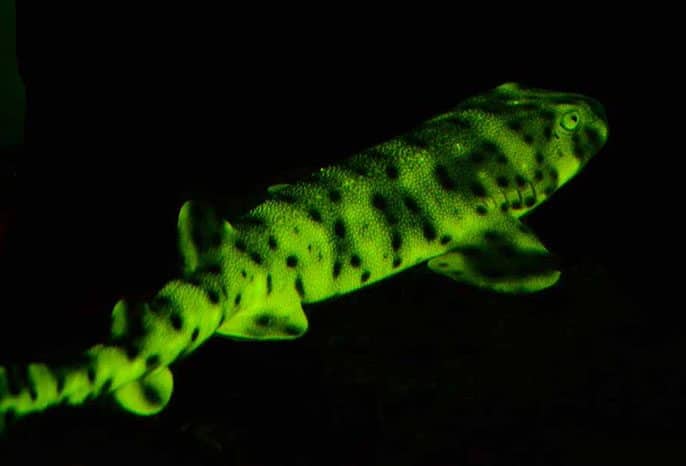A team of researchers including scientists from the American Museum of Natural History and Scripps Institution of Oceanography at University of California San Diego found that catsharks are not only able to see the bright green biofluorescence they produce, but that they increase the contrast of their glowing pattern when deep underwater. The study, conducted with a custom-built “shark-eye” camera, suggests that this trait helps catsharks recognize neighbors of the same species and may aid in communication between one another. The work was recently published in the journal Scientific Reports.
“This study provides the first evidence that sharks can see the fluorescence of their own species,” said Dimitri Deheyn, a researcher at Scripps and coauthor of the study. “It’s not just beautiful but has an ecological purpose.”
Unlike the full-color environment that humans and other terrestrial animals inhabit, fishes live in a world that is predominantly blue, because with depth, water quickly absorbs the majority of the visible light spectrum. In recent years, the research team has discovered that many fishes absorb the remaining blue light and re-emit it in neon greens, reds, and oranges. By designing lighting that mimics the ocean’s light along with cameras that capture the animals’ fluorescent light, the researchers were able to capture this hidden biofluorescent universe.
“We’ve already shown that catsharks are brightly fluorescent, and this work takes that research a step further, making the case that biofluorescence makes them easier to see by members of the same species,” said John Sparks, a curator in the American Museum of Natural History’s Department of Ichthyology and a co-author on the paper. “This is one of the first papers on biofluorescence to show this connection, and a big step toward a functional explanation for fluorescence in fishes.”
To further explore this phenomenon, the researchers focused on the visual ability of two different catsharks: chain catsharks (Scyliorhinus retifer) and swellsharks (Cephaloscyllium ventriosum). With the help of Cornell University veterinary expert Ellis Loew, the researchers used a technique called microspectrophotometry to determine how the sharks’ eyes absorb light, discovering that they have long rod pigments that help them see in low-light environments. They used this information to build a special camera filter that simulates how light hits a shark’s eyes.
Researchers then went on a number of expeditions to Scripps Canyon in San Diego County, where they observed swellsharks in their native habitat, about 100-feet (30-meters) underwater. During night dives, the team stimulated biofluorescence in the sharks with high-intensity blue light arrays housed in watertight cases. The resulting underwater light show is invisible to the human eye. To record this activity, the researchers used custom-built underwater cameras with yellow filters, which block out the blue light, as well as the newly developed “shark-eye” camera to get a better idea of how the shark sees the underwater display.
“Some sharks’ eyes are 100 times better than ours in low-light conditions,” said David Gruber, lead author of the study and an associate professor of biology at Baruch College and a research associate at the American Museum of Natural History. “They swim many meters below the surface in areas that are incredibly difficult for a human to see anything. But that’s where they’ve been living for 400 million years, so their eyes have adapted well to that dim, pure-blue environment. Our work enhances the light to bring it to a human perspective.”
By mathematically modeling images from the shark-eye camera, the researchers found that the contrast of the patterns on the biofluorescent sharks increases with depth, suggesting that the animals can not only see the light, but are also likely using it to communicate with one another.

